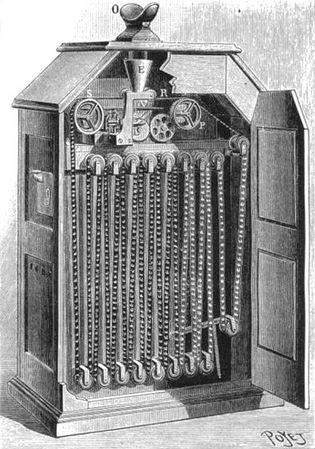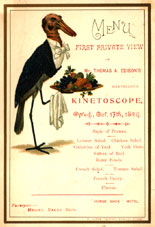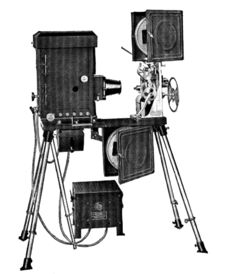كاينتوسكوپ
(تم التحويل من Kinetoscope)
كاينتوسكوپ Kinetoscope هو جهاز عرض السينما. وإن لم يكن لعرض الأفلام، وقد تم تصميمه ليتم عرضه لأفلام بشكل فردي من خلال نافذة.
التنمية

Sheet of images from one of the three Monkeyshines films (ca. 1889–90) produced as tests of an early version of the Kinetoscope
توجه الرأي العام

Construction on the imposing Black Maria began in December 1892. In order to take full advantage of sunlight, the tar paper–lined studio was equipped with a hinged, flip-up roof and the entire structure could rotate on a track. "It obeys no architectural rules," declared Dickson, who found it "productive of the happiest effects in the films."[1]

The first U.S. copyright for an identifiable motion picture was given to Edison for Fred Ott's Sneeze.
The June 1894 Leonard–Cushing bout. Each of the six one-minute rounds recorded by the Kinetograph was made available to exhibitors for $22.50.[2] Customers who watched the final round saw Leonard score a knockdown.
Kinetophone
إسقاط كاينتوسكوپ
انظر أيضاً
هوامش
- ^ Quoted in Baldwin (2001), pp. 232, 233.
- ^ Leonard–Cushing fight Part of the Library of Congress/Inventing Entertainment educational website. Retrieved 12/14/06.
المصادر
- Altman, Rick (2004). Silent Film Sound. New York: Columbia University Press. ISBN 0-231-11662-4
- Appelbaum, Stanley (1980). The Chicago World's Fair of 1893: A Photographic Record. New York: Dover. ISBN 0-486-23990-X
- Baldwin, Neil (2001 [1995]). Edison: Inventing the Century. Chicago: University of Chicago Press. ISBN 0-226-03571-9
- Braun, Marta (1992). Picturing Time: The Work of Etienne-Jules Marey (1830–1904). Chicago: University of Chicago Press. ISBN 0-226-07173-1
- Burns, Richard W. (1998). Television: An International History of the Formative Years. London: Institution of Electrical Engineers. ISBN 0-85296-914-7
- Cross, Gary S., and John K. Walton (2005). The Playful Crowd: Pleasure Places in the Twentieth Century. New York: Columbia University Press. ISBN 0-231-12724-3
- Dickson W.K.L. (1907). "Edison's Kinematograph Experiments," in A History of Early Film, vol. 1 (2000), ed. Stephen Herbert. London and New York: Routledge. ISBN 0-415-21152-2
- Edison, Thomas A. (1891a). "Kinetographic Camera" (U.S. patent application no. 403,534; witnessed and signed July 31, 1891; filed August 24, 1891), in Mannoni et al., Light and Movement, n.p.
- Edison, Thomas A. (1891b). "Apparatus for Exhibiting Photographs of Moving Objects" (U.S. patent application no. 403,536; witnessed and signed July 31, 1891; filed August 24, 1891), in Mannoni et al., Light and Movement, n.p.
- Gomery, Douglas (1985). "The Coming of Sound: Technological Change in the American Film Industry," in Technology and Culture—The Film Reader (2005), ed. Andrew Utterson, pp. 53–67. Oxford and New York: Routledge/Taylor & Francis. ISBN 0-415-31984-6
- Gomery, Douglas (2005). The Coming of Sound: A History. New York and Oxon, UK: Routledge. ISBN 0-415-96900-X
- Gosser, H. Mark (1977). Selected Attempts at Stereoscopic Moving Pictures and Their Relationship to the Development of Motion Picture Technology, 1852–1903. New York: Arno Press. ISBN 0-405-09890-1
- Grieveson, Lee, and Peter Krämer, eds. (2004). The Silent Cinema Reader. London and New York: Routledge. ISBN 0-415-25283-0
- Griffith, Richard, and Stanley William Reed (1971). "Motion Pictures," in Encyclopædia Britannica, 15th ed, vol. 15, pp. 898–918. Chicago et al.: Encyclopædia Britannica. ISBN 0-85229-151-5
- Guida practica per l'uso...del kinetoscopio Edison (n.a.; 1895–96). Milan: Edita dall' "Elettricità." Selected pages in Mannoni et al., Light and Movement, n.p.
- Gunning, Tom (1994 [1991]). D. W. Griffith and the Origins of American Narrative Film: The Early Years at Biograph. Urbana and Chicago: University of Illinois Press. ISBN 0-252-06366-X
- Hendricks, Gordon (1961). The Edison Motion Picture Myth. Berkeley and Los Angeles: University of California Press. Reprinted in Hendricks, Gordon (1972). Origins of the American Film. New York: Arno Press/New York Times. ISBN 0-405-03919-0
- Hendricks, Gordon (1966). The Kinetoscope: America's First Commercially Successful Motion Picture Exhibitor. New York: Theodore Gaus' Sons. Reprinted in Hendricks, Origins of the American Film.
- Jenness, Charles Kelley (1894). The Charities of San Francisco: A Directory of the Benevolent and Correctional Agencies. San Francisco: Book Room Print/Stanford University.
- Karcher, Alan J. (1998). New Jersey's Multiple Municipal Madness. New Brunswick, New Jersey, and London: Rutgers University Press. ISBN 0-8135-2565-9
- Mannoni, Laurent, Donata Pesenti Campagnoni, and David Robinson (1996). Light and Movement: Incunabula of the Motion Picture, 1420–1896/Luce e movimento: Incunaboli dell'immagine animata, 1420–1896. London: BFI Publishing/Le Giornate Del CInema Muto, Cinémathèque française–Musée du Cinéma, Museo Nazionale del Cinema. ISBN 88-86155-05-0
- Millard, Andre (1990). Edison and the Business of Innovation. Baltimore: Johns Hopkins University Press. ISBN 0-8018-3306-X
- Münsterberg, Hugo (2004 [1916]). The Film: A Psychological Study. Mineola, N.Y.: Dover. ISBN 0-486-43386-2
- Musser, Charles (1991). Before the Nickelodeon: Edwin S. Porter and the Edison Manufacturing Company. Berkeley, Los Angeles, and Oxford: University of California Press. ISBN 0-520-06986-2
- Musser, Charles (1994 [1990]). The Emergence of Cinema: The American Screen to 1907. Berkeley, Los Angeles, and London: University of California Press. ISBN 0-520-08533-7
- Musser, Charles (2002). "Introducing Cinema to the American Public: The Vitascope in the United States, 1896–7," in Moviegoing in America: A Sourcebook in the History of Film Exhibition, ed. Gregory Waller, pp. 13–26. Maiden, Mass., and Oxford: Blackwell (available online). ISBN 0-631-22591-9
- Musser, Charles (2004). "At the Beginning: Motion Picture Production, Representation and Ideology at the Edison and Lumière Companies," in Grieveson and Krämer, Silent Cinema Reader, pp. 15–28.
- Ramsaye, Terry (1986 [1926]). A Million and One Nights: A History of the Motion Picture Through 1925. New York: Touchstone (chapters 8–10 available online; part of the Adventures in CyberSound website). ISBN 0-671-62404-0
- Rausch, Andrew J. (2004). Turning Points in Film History. New York: Citadel Press. ISBN 0-8065-2592-4
- Robertson, Patrick (2001). Film Facts. New York: Billboard Books. ISBN 0-8230-7943-0
- Robinson, David (1996). "[Carmencita description]," in Mannoni et al., Light and Movement, n.p.
- Robinson, David (1997). From Peepshow to Palace: The Birth of American Film. New York and Chichester, West Sussex: Columbia University Press. ISBN 0-231-10338-7
- Rossell, Deac (1998). Living Pictures: The Origins of the Movies. Albany: State University of New York Press. ISBN 0-7914-3767-1
- Salt, Barry (1992). Film Style and Technology: History and Analysis. London: Starword. ISBN 0-9509066-0-3
- Schwartz, Vanessa R. (1999 [1998]). Spectacular Realities: Early Mass Culture in Fin-de-siècle Paris. Berkeley, Los Angeles, and London: University of California Press. ISBN 0-520-22168-0
- Spehr, Paul C. (2000). "Unaltered to Date: Developing 35 mm Film," in Moving Images: From Edison to the Webcam, ed. John Fullerton and Astrid Söderbergh Widding, pp. 3–28. Sydney: John Libbey & Co. ISBN 1-86462-054-4
- Stross, Randall E. (2007). The Wizard of Menlo Park: How Thomas Alva Edison Invented the Modern World. New York: Crown. ISBN 1-4000-4763-3
- Van Dulken, Stephen (2004). American Inventions: A History of Curious, Extraordinary, and Just Plain Useful Patents. New York: New York University Press. ISBN 0-8147-8813-0
- Zielinski, Siegfried (1999 [1989]). Audiovisions: Cinema and Television as Entr'actes in History, trans. Gloria Custance. Amsterdam: Amsterdam University Press. ISBN 90-5356-303-2
وصلات خارجية
![]() Media related to كاينتوسكوپ at Wikimedia Commons
Media related to كاينتوسكوپ at Wikimedia Commons
- Edison Motion Picture Equipment Chronology part of Professor Hall's Silent Movies website
- Machines illustrated survey of early cinematic equipment; part of the Who's Who of Victorian Cinema website
- "Motion Pictures" chap. 21 of Edison, His Life and Inventions (1910), by Frank Lewis Dyer (Edison lawyer) and Thomas Commerford Martin (AIEE ex-president)
- Technology: Kinetoscope essay with technical analysis of the system; part of the EarlyCinema.com website
- Voice Trial—Kinetophone Actor Audition by Frank Lenord mp3 audio file of undated audition; part of Project Gutenberg
- Voice Trial—Kinetophone Actor Audition by Siegfried Von Schultz mp3 audio file of undated audition; part of Project Gutenberg
أفلام كاينتوسكوپ
- Edison National Historic Site: Blacksmith Scene (1893), Sandow (1894), Serpentine Dance (ca. 1894–95), Edison at Work in His Chemistry Lab (n.d.). Note that The Kiss (1896) was shot not for the Kinetoscope but for Vitascope projection.
- Library of Congress: twenty-five films from 1891 through 1895






